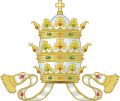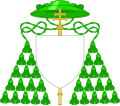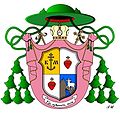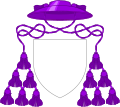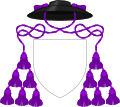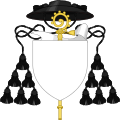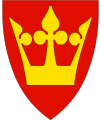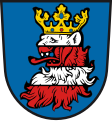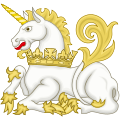Heraldic crowns
This gallery shows the main heraldic crowns of the world.
Commonwealth usage[edit]
 |
 |
 |
 |
 |
 |
 |
 |
 |
 |
 |
 |
 |
 |
 |
 |
Continental usages[edit]
Helmets are often substitutes for coronets, and some coronets are worn only on a helmet.
Andorra[edit]
|
Co-Princes
|
Bulgaria[edit]

|
Tsar
|

|
Tsaritsa
|
France[edit]
|
Ancien Regime[edit]
 King (after 1500's) King (after 1500's)
|
 Dauphin of France Dauphin of France
|
(fils de France )
|
|
|
|
| |
|
|
|
|
|
|
|
Napoleonic Empire[edit]
 Emperor EmperorFirst Empire |
 Emperor EmperorSecond Empire |
 Sovereign prince Sovereign prince
|
 Prince Prince
| |
 Duke Duke
|
 Count Count
|
 Baron Baron
|
 Knight Knight
|
d'honneur
|
July Monarchy[edit]

|
King of the French
|
Georgia[edit]

|
Georgian Royal Crown, also known as the "Iberian Crown"
|
German-speaking countries[edit]
Holy Roman Empire[edit]
 Imperial Crown Imperial Crown
|
King of the Romans |
 Older Crown of the Older Crown of theKing of the Romans |
 Newer Crown of Newer Crown ofthe King of the Romans |
 King of Bohemia King of Bohemia
|
 Archducal hat Archducal hat
|
 Oldest Electoral hat Oldest Electoral hat
|
 Older Electoral hat Older Electoral hat
|
 New Electoral hat & New Ducal hat New Electoral hat & New Ducal hat
|
 Ducal hat of Styria Ducal hat of Styria
|
 Ducal crown Ducal crown
|
 Princely hat Princely hat
|
 Princely crown Princely crown
|
 Crown of a Landgraf Crown of a Landgraf
|
 Crown of an heir to a duchy Crown of an heir to a duchy
|
|
|
|
|
|
Liechtenstein[edit]

|
Prince of Liechtenstein
|
Austria[edit]
 Mural crown of the coat of arms of Austria Mural crown of the coat of arms of Austria
|
|
Austrian Empire
 Emperor Emperor
| |||||
 King of Bohemia King of Bohemia
|
 Archducal crown (New) Archducal crown (New)
|
 Archducal hat (Older) Archducal hat (Older)
|
 Ducal hat of Styria Ducal hat of Styria
|
 New Ducal hat New Ducal hat
|
 Prince Prince
|
|
|
|
|
|
|
Germany[edit]
German Empire
 German State Crown German State Crown
|
 Empress Empress
|
 Crown Prince Crown Prince
|
 King of Prussia King of Prussia
|
 King of Bavaria King of Bavaria
|
 Crown of Württemberg Crown of Württemberg
|
Greece[edit]

|
King
|
Hungary and Croatia[edit]
Hungary[edit]

|
Holy Crown of Hungary (crown of Saint Stephen)
|
Croatia[edit]

|
Crown of Zvonimir (crown of King Demetrius Zvonimir)
|
Italy[edit]
|
Kingdom of Italy (1861-1946)[edit]
 King (crown of Savoy) King (crown of Savoy)
|
 Crown Prince Crown Prince
|
 Royal prince [3] Royal prince [3]
|
|
|
|
|
|
|
|
|
|
|
|
|
Kingdoms of Naples, Sicily, Two Sicilies[edit]
 King of Naples King of Naples
|
 Heir to the throne (Duke of Calabria) Heir to the throne (Duke of Calabria)
|
 Prince and princess Prince and princess
|
Grand Duchy of Tuscany[edit]
 Habsburg-Lorraine Grand Dukes of Tuscany Habsburg-Lorraine Grand Dukes of Tuscany
|
Other Italian states before 1861[edit]
 Crown of San Marino Crown of San Marino
|
 Crown of Napoleonic Italy Crown of Napoleonic Italy
|
|
 Papal Tiara Papal Tiara
|
 Doge of Venice Doge of Venice
|
 Doge of Genoa Doge of Genoa
|
Low Countries[edit]
Netherlands[edit]
 Emperor Emperor
|
 King King
|
 Prince Prince(children of the Monarch)
|
 Prince Prince(grandchildren of the Monarch) |
 Prince Prince(nobility, for titles granted after 1815)
|
 Duke Duke
|
|
|
(alternative style)
|
|
|
(Erfridder) |
|
|
Belgium[edit]
− The older crowns are often still seen in the heraldry of older families.
Luxembourg[edit]

|
Grand Duke
|
Monaco[edit]

|
Prince
|
Poland and Lithuania[edit]
 Heraldic Crown of the King Heraldic Crown of the King
|
 Crown of Bolesław I the Brave of Poland Crown of Bolesław I the Brave of Poland
|
 Grand Duke Grand Duke
|
 Prince Prince
|
Portuguese-speaking countries[edit]
Portugal[edit]
(1930-1999) |
(unused) |
Kingdom of Portugal (until 1910)
 King King
|
 Crown Prince Crown Prince
|
 Prince of Beira Prince of Beira
|
 Infante Infante
|
|
|
|
Brazil[edit]
| Capital
|
City
|
Town | Village |
Empire of Brazil
 Emperor Emperor
|
 Prince Imperial Prince Imperial
|
 Prince Prince
|
|
Romania[edit]

|

|

|

|
| Capital | City
|
Town | Village |
Former Kingdom of Romania[edit]

|
King (The Steel Crown of Romania)
|
Russia[edit]
 Emperor Emperor
|
 crown of the grand duchy of Finland crown of the grand duchy of Finland
|
 Monomakh Crown Monomakh Crown
|
 Prince Prince
|
|
|
|
Nordic countries[edit]
Denmark[edit]
 King King
|
 Crown Prince Crown Prince
|
 Prince Prince(royal family) |
|
|
|
|
Finland[edit]
During the Swedish reign, Swedish coronets were used. Crowns were used in the coats of arms of the historical provinces of Finland. For Finland Proper, Satakunta, Tavastia and Karelia, it was a ducal coronet, for others, a comital coronet. In 1917 with independence, the coat of arms of Finland was introduced with a Grand Ducal coronet, but it was soon removed, in 1920. Today, some cities use coronets, e.g. Pori has a mural crown and Vaasa a Crown of Nobility.
 King King
|
 Crown Prince Crown Prince
|

|
Ducal coronet Satakunta
|

|
Comital coronet Savo
|
Norway[edit]
 King King
|
 Queen Queen
|
|
|
|
|
|
|
Sweden[edit]
 King King
|
|
|
|
|
|
Serbia[edit]

|
King
|
Spain[edit]
 King National arms design King National arms design
|
 King Monarch's arms design King Monarch's arms design
|
 King (Aragon, Catalonia, Balearics, Valencia) King (Aragon, Catalonia, Balearics, Valencia)
|
 Crown Prince Crown Prince
|
 Crown Prince (Aragon, Catalonia, Balearics, Valencia) Crown Prince (Aragon, Catalonia, Balearics, Valencia)
|
 Infante Infante
|
 Infante (Aragon, Catalonia, Balearics, Valencia) Infante (Aragon, Catalonia, Balearics, Valencia)
|
 Grandee of Spain Grandee of Spain
|
|
|
| |
|
|
|
Ukraine[edit]
 King Galicia–Volhynia King Galicia–Volhynia
|
Non-European usages[edit]
Mexico[edit]

|
Emperor (1st Empire) |

|
Emperor (2nd Empire) |
Egypt before 1953[edit]

|
Khedive (-1914) and Sultan (1914-22)
|

|
King (1922-53) |
Siam and Thailand[edit]

|
Great Crown of Victory of the Kings of Siam and Thailand |

|
Phra Kiao (princely coronet, also the emblem of King Chulalongkorn) |
Polynesia[edit]
 Royal Crown of Fiji Royal Crown of Fiji
|
 Royal Crown of Hawaii Royal Crown of Hawaii
|
 Royal Crown of Tahiti Royal Crown of Tahiti
|
 Royal Crown of Tonga Royal Crown of Tonga
|
 Royal Crown of Rapa Nui Royal Crown of Rapa Nui
|
Other examples[edit]
 Raven Crown of Bhutan Raven Crown of Bhutan
|
 The Crown of Brunei The Crown of Brunei
|
 Imperial Crown of China Imperial Crown of China
|
 Imperial Crown of Ethiopia Imperial Crown of Ethiopia
|
 Crown of the Shah of Iran (Pahlavi dynasty) Crown of the Shah of Iran (Pahlavi dynasty)
|
 Crown of the Shah of Iran (Qajar dynasty) Crown of the Shah of Iran (Qajar dynasty)
|
 Crown of the Kara-Kyrgyz Khan Crown of the Kara-Kyrgyz Khan
|
 The Crown of Nepal The Crown of Nepal
|
 The Crown of Rwanda The Crown of Rwanda
|
Roman Catholic Church[edit]
-
Eastern Catholic prelate, combining elements of both Eastern and Western ecclesiastical heraldry
-
Apostolic protonotary (Monsignor)
-
Honorary Prelate (Monsignor)
-
Chaplain of His Holiness (Monsignor)
Multinational[edit]
 Celestial crown Celestial crown
|
|||
As a charge[edit]
In heraldry, a charge is an image occupying the field of a coat of arms. Many coats of arms incorporate crowns as charges. One notable example of this lies in the Three Crowns of the arms of Sweden.
Additionally, many animal charges (frequently lions) and sometimes human heads also appear crowned. Animal charges gorged (collared) of an open coronet also occur, though far less frequently.
-
A crowned lion head in the arms of Kreis Biedenkopf, a county in Hesse, Germany (1832-1974)
-
The Three Crowns, as well as lions and leopards crowned, in the arms of Eric of Pomerania
-
Badge of the Unicorn Pursuivant, a unicorn gorged of a coronet
Notes and references[edit]
- ↑ Boutell, Charles (1914) Fox-Davies, A.C. , ed. Handbook to English Heraldry, The (11th ed.), London: Reeves & Turner, pp. 104–156
- ↑ a b This standard has many exceptions.
- ↑ The dukes of Genoa were granted the privilege to use a crown of royal prince though they were only princes of the blood









